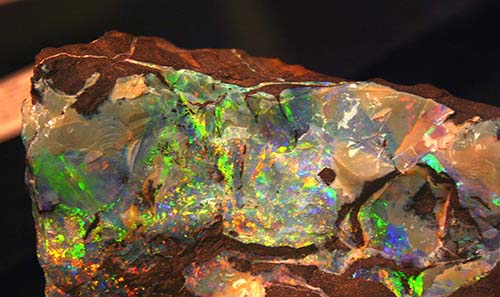Phenomenal Mineral Colors
Internal Structures Produce Optical Effects
By Admin - July 17, 2019

Tiger’s-eye, which consists of asbestos invaded by silica, is a very useful chatoyant gemstone with a silky luster. (Photo Bob Jones)
Story by Bob Jones
"Collectors understand that minerals owe their colors to several different causes, including impurities and the elements in a mineral’s normal chemical makeup. But a host of minerals get their color from some internal structure, called a physical phenomenon, that affects the way light is reflected to the viewer.
Opal is a well-known example of a mineral whose color is caused by a physical phenomenon called “diffraction.” Other phenomena include iridescence, a rainbow effect seen in iris quartz and pearls; chatoyancy, which we see in cat’s-eye stones and some malachite; asterism, which is displayed in star stones; aventurescence, as seen in aventurine quartz and sunstones; adularescence, seen in moonstone; and play of color, or the alexandrite effect, seen in the alexandrite variety of chrysoberyl and some garnets. In every one of these groups, the cause of the color is related to some internal physical structure and not a metallic impurity or element in the mineral’s structure.
Silica Spherules Spreads Color
For centuries, people tried to explain the play of color seen in many opals. Finally, in the 1960s, we developed equipment that could actually see the internal structure of opal. It revealed a very orderly arrangement of submicroscopic spherules of silica. These spherules and the spaces between them acted as a diffraction grating, spreading light into its various colors. The sizes of these spherules and the angle at which the light struck them, coupled with the viewer’s angle, determined which color wavelengths were cancelled out and which ones were reflected. Diffraction of light results in opal’s play of color.

Diffraction caused by perfectly aligned tiny spherules of silica split light into its lovely colors in precious opal. (Bob Jones)
A much more common mineral that gets its play of color from diffraction is the feldspar mineral labradorite. This massive mineral can develop in huge formations, resulting in outcrops that give off flashes of color. I can recall walking around inside the Kremlin, in Moscow, and being amazed when I saw huge blocks of labradorite used as curbing around large flowerbeds. In sunlight, these huge rocks flashed colors bright enough to catch the eye from many yards away.
Labradorite crystallizes in very thin wafers in parallel layers that repeat to form a diffraction grating. This grating has the effect of separating light into its various colors, giving labradorite a play of color that depends, in part, on the angle of the source of light. The thickness of each crystal and each cluster of crystals in their parallel layers also affects which color is seen. So, labradorite can flash bronze, blue, green and, in some cases, red or violet in an overall groundmass of gray to blue. It is thought the gray color of the groundmass is due to the scattering of light by the internal structure.
Another attractive feldspar mineral is adularia. Like labradorite, it develops as very thin crystals that line up in parallel arrangement and act as a diffraction grating.
Play of Color
But adularia does not show a play of color. The twinned arrangement of the crystals simply scatters light. While it can also be shades of gray, pink, peach, green and brown, it is best known for a bluish-white color that is reminiscent of the moon.
Properly cut adularia gives off a cloudy sheen that seems to float throughout the polished stone. We give this lovely form of adularia the name “moonstone”. You might wonder why adularia has little color, while labradorite is a riot of color.
This is due to ... "
https://www.rockngem.com/phenomenal-min ... tter071819